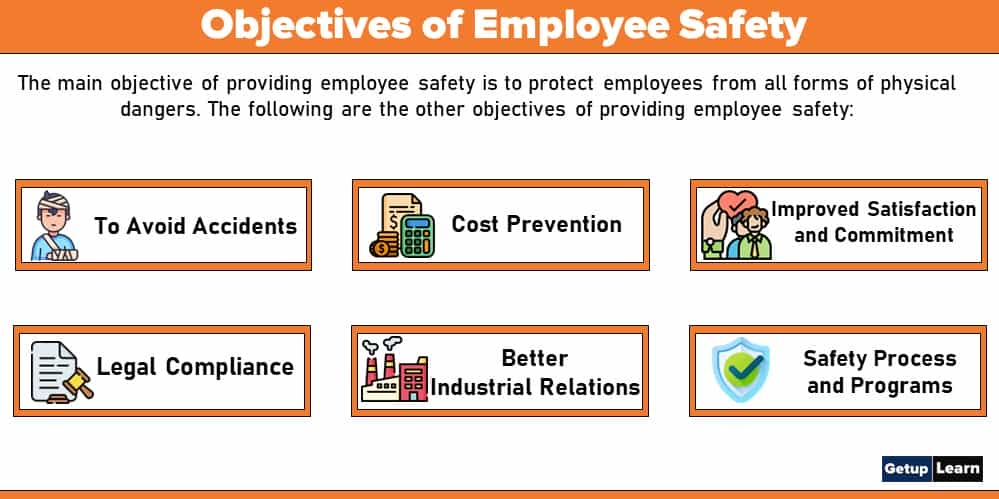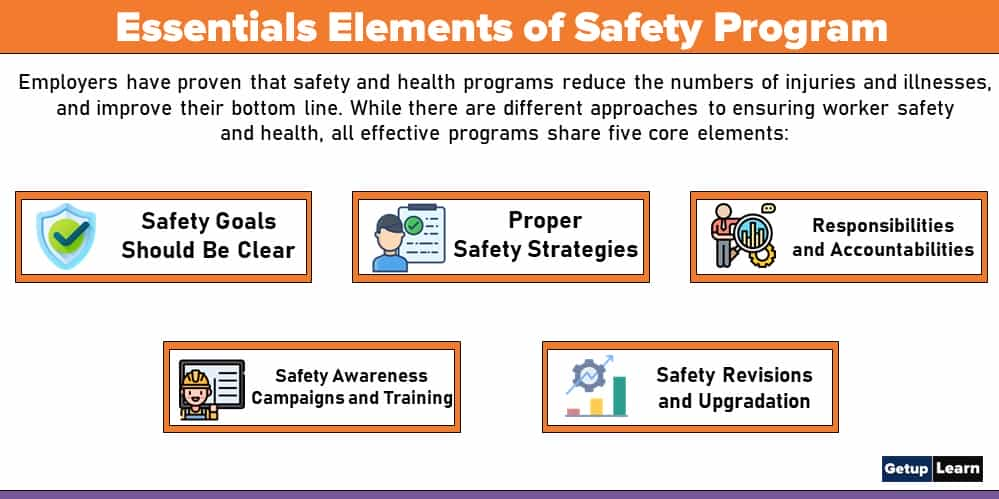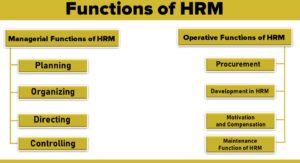Table of Contents
What is Employee Safety?
Employee safety involves protecting employees from injuries caused by work-related accidents. In other words, Safety, both physical and psychological safety, is present when people are free from being bodily harmed.

Objectives of Employee Safety
The main objective of providing employee safety is to protect employees from all forms of physical dangers. The following are the other objectives of providing employee safety:
- To Avoid Accidents
- Cost Prevention
- Improved Employee Satisfaction and Commitment
- Legal Compliance
- Better Industrial Relations
- Formalizing the Safety Process and Programs

To Avoid Accidents
The main objective of providing employee safety is to reduce the possibility of accidents by setting up appropriate safety devices in the premise and educating the employees about the various safety aspects.
Cost Prevention
It reduces the costs which are incurred by the organisation due to various accidents. Due to proper safety measures, the amount payable for compensation for accidents caused as well as for hospitalization are reduced.
Improved Employee Satisfaction and Commitment
Safety measures promote an environment which is safe which results in increased satisfaction and motivation. The employees when they get safe environment for doing job fulfill the expectations of the employees regarding job satisfaction and motivation.
Legal Compliance
Many times, organisations undertake employee safety measures due to legal provisions. Such requirements are specified in various acts such as Factories Act, 1948 and Industrial Disputes Act, 1947.
Better Industrial Relations
Through employee safety measures, the relations between labour and management becomes more cordial. When the management ensures safety of employees, a positive feeling is developed among the employees, which establishes cordial and harmonious relationship in the organisation.
Formalizing the Safety Process and Programs
The introduction of employee safety helps in educating the employees to accept such safety measures and maintain such awareness program by making them a part of the organisation culture.
Steps in Employee Safety Programs
Organisations develop and design their own safety programs which depend on their own requirements. The following are the steps in an employee safety program:
- Assessing Dangers
- Review Existing Safety Measures
- Safety Devices Installation
- Safety Training
- Safety Compliance and Verification
- Periodic Review of Safety Standards

Assessing Dangers
In order to develop and design their own safety program, the organisation should assess the various hazards that are associated with the jobs that have to be performed by the employees. This is done to determine the nature and the level of safety measures required for creating a safe working environment.
In order to do so, a close study of the activities of the machine operators is undertaken. Once this is done, the nature of the hazards could be determined and then preventive measures for them could be developed.
Review Existing Safety Measures
When new machines are installed, a review of existing safety measures should be undertaken to see if any new arrangements have to be made. Further, the existing safety measures should be reviewed to ensure that the safety measures which are in place meet the hazards that the employees might face.
For this, experts should be called to ensure that if any additional safety measures have to be introduced.
Safety Devices Installation
Once the review of safety measures is undertaken, and then if required, new safety devices have to be installed. However, such an action is not required in case if the safety measures in place are adequate.
Safety Training
Once the safety devices are installed, the employees have to be trained so that they follow the safety instructions in an appropriate manner. Here, it is very important that the employers educate their employees in an adequate manner. For this, periodic orientation and training programs have to be undertaken.
In such programs, a briefing regarding do’s and don’ts of operating such machines have to be provided. Safety programs may also be conducted by the manufacturer when such machines are bought.
Safety Compliance and Verification
In order to ensure that all safety measures which are required are followed, it is important that the employees follow all safety measures. Safety measures should be adopted by the organisation as part of its culture. Necessary safety audits could also be conducted to verify that all safety measures are followed by the employees.
For undertaking safety audits, safety checklists can be used for gathering information about how the existing safety regulations are implemented.
Periodic Review of Safety Standards
As safety is a concern of utmost importance, periodic review of all the safety measures has to be undertaken. In order to make the necessary changes, it is important that the safety measures taken are flexible. Such safety measures should ensure that the employees get a sense of satisfaction while working in the organisation.
The measures which are in place in the organisation in current time should be so that new safety techniques are introduced without any difficulty.
Importance of Employee Safety
These are the following importance of employee safety:
- Loss of Human Life
- Financial Cost to Employer
- Insurance Premium Cost
- Punitive Measures for Lapses in Safety

Loss of Human Life
Any life is precious and it is important that the safety of human life is ensured by the organisation. An injured employee suffers physical pain but also mental agony. Moreover, if a life of an employee is lost, the whole family of that employee faces problem. In order to prevent all these consequences, appropriate safety measures have to be ensured by the organisation.
Financial Cost to Employer
When an organisation losses the services of its employees, then the organisation would have to compensate for the losses that incur to that employee. Moreover, a new employee has to be trained and the production process also gets disrupted. As a result, the cost of labour might also increase.
The insurance premium that is to be paid by the organisation depends on the insurance claims made by the organisation due to deaths and injuries caused to the employees. When an organisation has a high number of accidents, the insurance premium paid by the organisation also increases.
On the other hand, in the case of organisations where the number of accidents is less, the insurance premium paid by the organisation is also less. Such a reduction in the premium due to reduced number of accidents is known as “No Claim Bonus’. So, to avail of such benefits, it is necessary that the organisation maintains the safety devices in such a manner that it is free from any accidents.
Punitive Measures for Lapses in Safety
In case if the safety measures are inadequate, under the provisions of the Factories Act, 1948, a fine may be imposed or the employers may be imprisoned. When any industrial accident is reported, appropriate authority issues an order which prosecutes the management for negligence on the part of the employers.
In order to avoid such actions, the management ensures that appropriate safety measures are undertaken in the organisation.
Essentials Elements of Safety Program
The following are essentials elements of safety program:
- Safety Goals Should Be Clear
- Proper Safety Strategies
- Well Defined Responsibilities and Accountabilities
- Safety Awareness Campaigns and Training
- Safety Revisions and Upgradation

Safety Goals Should Be Clear
Before designing a safety program for an organisation, it is essential that a clear goal for such a program is determined. Moreover, it has to be ensured that such programs comply with all statutory provisions. It should also be ensured that the goals which are set are in sync with the policies of the organisation.
Proper Safety Strategies
The strategies for accomplishment of safety goals must be properly designed. Fixing safety goals may include fixation of realistic performance targets, determining financial incentive for accident free performance, enforcing reporting and accountability, identifying and acknowledging the best practices that reduce accidents and injuries and formulating strategies for seeking cooperation of employees and the trade unions on safety measures.
Well Defined Responsibilities and Accountabilities
One of the important criteria for defining responsibilities and accountabilities is developing a safe working environment. But it is important that people are made responsible for creation and maintenance of safe occupational environment. The lines of responsibility and accountability must be defined so that security lapses are avoided.
Safety Awareness Campaigns and Training
Organisations should conduct safety programs at periodic intervals to ensure that accidents are avoided. A topic for discussion may be chosen for a training program. Such topics may range for eye and face safety, respiratory safety, fire preventions, first aid, etc.
The performance records and safety records of employees are very important documents which determine the safety needs of the employees. To determine such needs, interviews may also be conducted.
Safety Revisions and Upgradation
When new machinery is installed or when government legislations change, the organisation may have to revise the safety regulations. It may be possible that due to such revisions, stricter safety measures have to be enforced. It may also be possible that new safety measures may also have to be enforced when the causes of the latest accidents are identified.
To solve such incidents, organisations may have to periodically review the safety measures to understand the gaps in safety measures enforced in the organisation.
What is the importance of employees safety?
Loss of Human Life, Financial Cost to Employer, Insurance Premium Cost, Punitive Measures for Lapses in Safety etc are reasons why employees safety is important.
What are the objectives of employee safety?
1. To Avoid Accidents
2. Cost Prevention
3. Legal Compliance
4. Better Industrial Relations
5. Formalizing the Safety Process and Programs
6. Improved Employee Satisfaction and Commitment
These are the objectives of employee safety.
What are the 6 steps of safety?
1. Assessing Dangers
2. Review Existing Safety Measures
3. Safety Devices Installation
4. Safety Training
5. Safety Compliance and Verification
6. Periodic Review of Safety Standards
These are the 6 steps of safety Programs.















